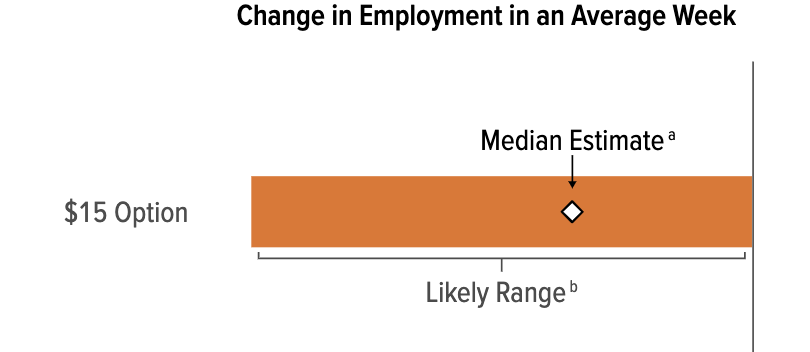The Democratic presidential candidates are in agreement on a proposal to eliminate 1.3 million jobs nationwide.
That’s not the way they would frame the issue, of course. Saying that you will eliminate over a million jobs held by the poorest people in America is not exactly a winning message. Instead, they frame it as a pay increase—a doubling of the federal hourly minimum wage from $7.25 to $15 by 2025. Will Americans be fooled?
The Congressional Budget Office (CBO), an independent, nonpartisan federal agency within the legislative branch that provides analyses of budgetary and economic issues to support the Congressional budget process, released a new report titled, “The Effects on Employment and Family Income of Increasing the Federal Minimum Wage.” According to the report, in an average week in 2025, the $15 option would boost the wages of 17 million workers who would otherwise earn less than $15 per hour. Another 10 million workers otherwise earning slightly more than $15 per hour might see their wages rise as well.
But 1.3 million other workers would become jobless, according to CBO’s median estimate. There is a two-thirds chance that the change in employment would be between about zero and a decrease of 3.7 million workers. CBO’s estimates are based on the median values of likely ranges for wage growth and the responsiveness of employment to changes in wages. As the report notes, the likely ranges for the responsiveness parameter are not symmetric: That value has an equal chance of being smaller or larger than the median, but if it is larger, it could be substantially larger.
In other words, there is about an equal possibility that the raise would be smaller—maybe a few hundred thousand jobs lost. And there is the equal possibility that it would eliminate as many jobs as were created in all of 2018 and half of 2017. Here’s a chart from the report that shows the range.
Guess which end of the range the Democrats will focus on?
The Democrats will rely on the innumeracy of the average American to sell the destructive policy. They are counting on the typical voter to think that the effect of the wage increase will likely be close to zero. Voters won’t know the outcome until it’s too late.
If we want to help the poor a better approach would be to leave the minimum wage alone and increase the Earned Income Tax Credit (EITC). As the CBO report finds, an increase in the credit amount available in the EITC would go almost entirely to lower-income families, whereas an increase in the minimum wage raises earnings for many workers who are not in low-income families as well. For example, roughly 40 percent of workers directly affected by the $15 option in 2025 would be members of families with income more than three times the federal poverty threshold.
Why isn’t the EITC the more attractive option? Because, as the report states, increasing the EITC would require some combination of increased taxes, reduced spending in other areas, or larger budget deficits. It’s easier to raise the minimum wage and pretend that business will bear the cost than to make a change that would require sacrifice. Unfortunately, neither party is currently willing to do what is right for the working poor. But we can at least try to stop them from putting more poor people out of work.


